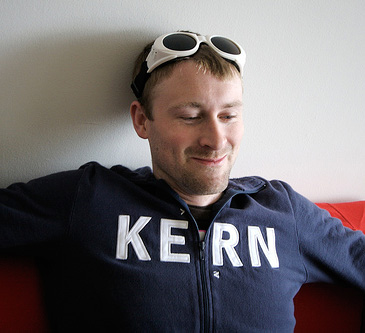 Patrick Haney is not a sausage. He is a user interface designer at Harvard University. He keeps a really great blog about design which we’ve been following for a while now so we think you’ll be inspired to read about Patrick here:
Patrick Haney is not a sausage. He is a user interface designer at Harvard University. He keeps a really great blog about design which we’ve been following for a while now so we think you’ll be inspired to read about Patrick here:
How or where do you find inspiration?
I find inspiration everywhere, not just by browsing through CSS galleries (though that’s not a bad way to find web design ideas). Sometimes I find it thumbing through a magazine, other times it’s hidden away in signage or architecture in the world around me. From business cards to art galleries, inspiration is everywhere.
Who is the biggest influence on your work right now?
A lot of small design agencies are doing things right. Whether we’re talking 1 or 2 people shops like SimpleBits or a handful of people at Happy Cog, there’s something to be said for staying small and focusing on putting out quality work. These talented people do great work and know how to deliver what the client needs.
Where are your “design roots”? Print or Web?
I started in the web world, though I’m always fascinated with the print side of things, especially when it comes to letterpress.
How important is it to know the history of design?
Whether it’s important or not, many people who call themselves “web designers” never had formal design training, myself included. Is that a bad thing? I tend to think it isn’t, though of us without a design degree shouldn’t skip out on design principles altogether. I often wish I had taken classes in college that covered things like typography, color or alignment.
Serif or Sans? Sans-serif.
Do you code and design? Are you a “Hybrid”?
Starting college as a Computer Science major ended up being somewhat useful after switching to another major a year later, as I learned some important programming knowledge I might have otherwise missed completely. For a while I did a lot of web programming in things like ASP, ColdFusion and PHP, but now I stick to HTML and CSS mostly when I’m not doing actual design work.
What’s your favorite part of the creative process?
Concepting is great because you get to think outside of the box a lot, but with the users’ needs in mind. Whether the design is in my head or in a sample mockup, I find that I end up having a lot of fun at this stage of the game.
What makes your creative process different from everybody else?
The fact that I don’t really have a “process” per se. Yes, there’s sketching and wireframing and mockups and finalized designs that then get “cut” into HTML and CSS, but I don’t go through all of those stages for every project. And sometimes there are other steps. It all depends on the client, the project, the timeframe, and any number of other factors that come up on a daily basis.
What do you see as the single biggest shift in the evolution of design over the past 5 years?
On the web, design has seriously been affected by the development of better browsers, and mostly for the better. Safari, Opera, Firefox, and even Internet Explorer are pushing the line for what we can do on the web. I feel like we’ve got a long ways to go yet, but things are drastically better now than they were even just a few years ago.
What’s the difference between User Experience and User Interface design?
Since I’m technically a User Interface Designer myself, I should be able to answer this question. The problem is, the lines between job descriptions are often blurred. I find myself working on both UI and UX problems more often tha not. To me, UI is about optimizing the interface of a site or application to be the most useful for users, where UX deals with the interactions of each screen of a product (or website) and how they fit together.
What makes one a web design professional?
That’s a loaded question, but I would wager that the quality of someone’s work and their experience tells you if they’re a “professional” or not. Then again, it seems like everyone can be (and is) a web design professional these days.
What are designers/developers doing right (or wrong) in the web 2.0 world?
The term “web 2.0” actually makes me cringe a little, but the worst thing to me is when it’s applied to design. Let it be known that “web 2.0” is not a design style, it refers to the need for collaboration, information sharing and openness of the web as it is today.
What’s your favorite flavor of design or development programs/languages?
Fireworks has become my tool of choice, replacing Photoshop a few years back due to its optimization for web folks. I write all my code in TextMate though, dropping Dreamweaver’s extra functionality altogether (though I hear it’s a decent tool these days). My MacBook has enough web browsers to use a new one every day of the month, and Firebug along with WebKit’s Web Inspector are invaluable tools for discovering flaws in my markup and stylesheets.
What is your favorite book?
Forget all those books on design, CSS, and web standards. The best book you can buy is called Lamb: The Gospel According to Biff, Christ’s Childhood Pal. It’s written by Christopher Moore, who I dare say is one of the best writers of comedy I have ever read, and it’s worth reading regardless of your religous alignment (or lack there of).
What is your favorite movie?
There are plenty of good options on my list, but the top spot is probably between Ghostbusters (a classic), The Matrix (the first and only one that really matters), and Happy Gilmore (yes, I know how ridiculous that sounds).
Who is your favorite musical artist (or What musical artist are you listening to the most right now?)
Portishead is fantastic to listen to just about any time, but especially when doing design work. One of their best songs, and one of my favorite songs of all time, is Roads. It puts me in a trance whenever I listen to it.
Patrick Haney is not a sausage. He does however enjoy design, typography and talking about himself in the third person. Though he started off writing code at school and then at big, overwhelming companies like Kodak and Xerox, design is where he truly feels inspired and motivated.
He writes about all sorts of things on his website and is always aspiring to learn more about design and the web, which is probably why he’s seen at so many conferences, where you might spot him wearing a KERN sweatshirt.





0 Comments